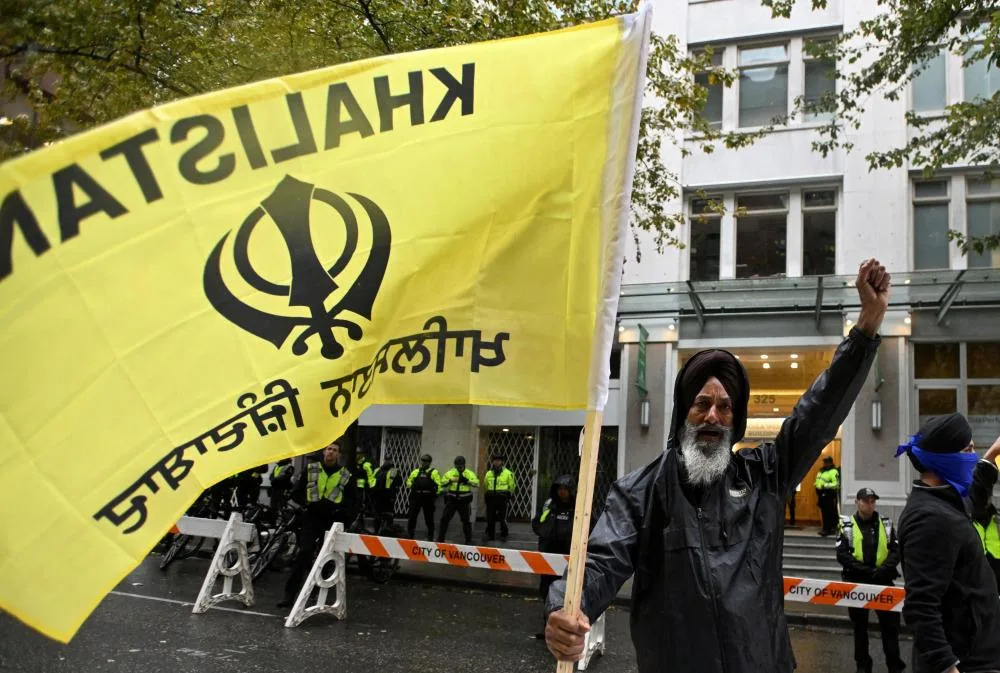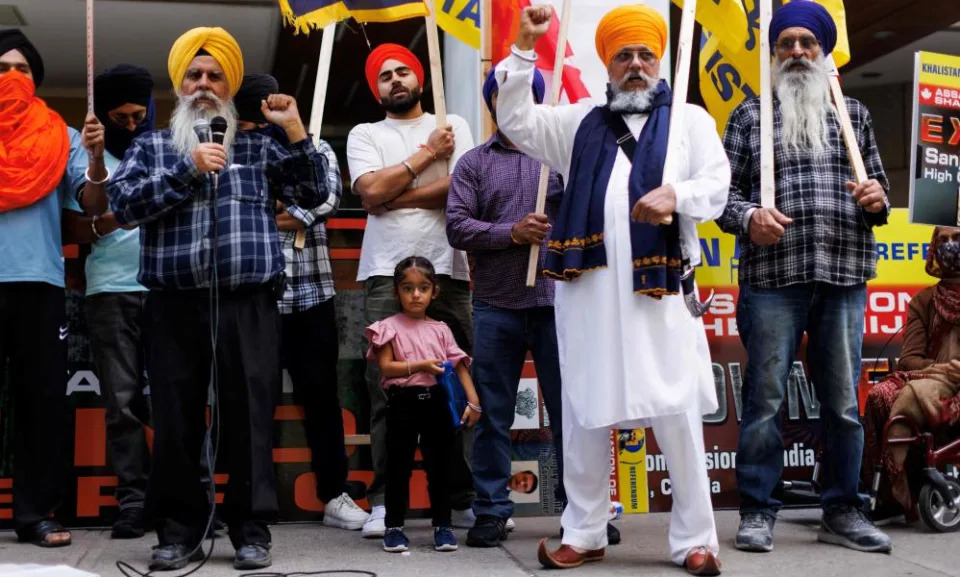Angela Hume
Tue, September 26, 2023

“Stop Operation Rescue” poster, October 1988, by Joe and Agnes Sampson. Photo from Joe and Agnes Sampson’s personal collection. Photo illustration by Slate.
Adapted from Deep Care: The Radical Activists Who Provided Abortions, Defied the Law, and Fought to Keep Clinics Open by Angela Hume. AK Press, forthcoming Nov. 14, 2023.
Deep Care follows generations of activists and health workers who orbited Women’s Choice Clinic in Oakland, California, from the early 1970s until 2010, as they worked underground and aboveground, in small cells and broad coalitions. The book is grounded in interviews with activists sharing details of their work for the first time and reveals a story of the radical edge of the abortion movement. The following is an excerpt from Chapter 6: “Your First Line of Defense Is Self-Defense.”
By the mid-1980s, almost 90 percent of abortions were performed at stand-alone clinics, but it was getting harder to be a Feminist Women’s Health Center. (FWHCs were independent abortion and reproductive health care providers operated by feminist-identified laypeople.) The right wing that elected Ronald Reagan president in 1981 had worked throughout the 1970s to recruit and fold free-market conservatives and white Christians into a single, powerful base. By the 1980s, the far-right fringe of this new right wing produced a terroristic anti-abortion campaign. Violence hit Oakland Feminist Women’s Health Center, also known as Women’s Choice Clinic, close to home in 1985, when arsonists firebombed one of its sibling clinics in Los Angeles.
How did the anti-abortion movement become such a leviathan? In the late 19th and early 20th centuries, the movement mainly included white supremacists who, pointing to declining white birth rates, believed that legalized abortion would mean “race suicide” for white Protestants. Later, in the 1960s, leading up to the ruling on Roe v. Wade, the movement became a Catholic one too. After Roe, the church intensified its crusade against abortion, and other conservative groups joined in interpreting the ruling as a rejection of traditional values; newly galvanized, these other religious and interest groups joined the movement.
Starting in the 1970s, the anti-abortion movement began to push for laws that prohibited public funding for abortions. At the same time, Republican politicians were advocating that the government divest from families by slashing public benefits (welfare), further racializing poverty. The anti-abortion movement and Republicans in Congress came together to pass the Hyde Amendment, which in 1977 banned Medicaid reimbursements for abortion. The Republican anti-welfare campaign had come to imply an anti-abortion stance. And the implied equation of welfare and abortion—and the imperative to reject both—would animate the right for decades to come.
By the early 1980s, there had been bombings and arsons of clinics by anti-abortion terrorists nationwide. Anti-abortion aggression did not stop the FWHCs from providing services, but on the morning of April 8, 1985, arsonists attacked the L.A. clinic. No one was ever convicted, and the Los Angeles Fire Department never declared the fire to be arson, even though the health center had received threats.
Over the course of the 1980s, the United States lost almost 20 percent of abortion providers. In the words of longtime Women’s Choice Clinic Director Linci Comy, the attacks were spearheaded by “very angry men.” “This was a fight about male superiority,” she told me. “And the worst of the right wing came out to join that struggle. Not only were they women haters, but they were queer haters. It was a Christian militia.”
To grasp what a feat it was for Women’s Choice to survive the war years, which started in the 1980s and escalated in the 1990s, you have to look at the lengths activists were willing to go to defend their clinics.
In January 1985, three months before the L.A. clinic firebombing, a director at Women’s Choice named Pat Parker suggested to her comrades that they get serious about self-defense. She started a group to talk about how they should respond to the anti-abortion attacks. They named their group the Clinic Defense Committee and called for a “Bay Area–wide, broad-based coalition of support for reproductive rights.” Not long after, the committee would rename themselves Bay Area Coalition Against Operation Rescue when the militant organization Operation Rescue came on the scene.
Operation Rescue would organize abortion clinic “hits” (as clinic defenders called them), in which hundreds of OR members would mob a single abortion clinic. So BACAOR members rose up, executing an unprecedented and militant street response that reflected their understanding that abortion access was a condition for everyone’s freedom and autonomy, and that clinic defense was community self-defense.
Sept. 17, 1988, was set to be Operation Rescue’s first big hit in the Bay Area. When I visited BACAOR member Kass McMahon at her home in Albuquerque, I spent a week rummaging through her plastic bins full of records and ephemera. Kass took copious notes over the years. She was a trained journalist, she explained to me, with a facility for documenting.
Early that September morning, 50 or so BACAOR members arrived at a clinic called Pregnancy Consultation Center in San Francisco to find hundreds of OR demonstrators blocking the doors. Arriving in vans, the antis had descended upon the clinic well before sunrise and, in no time at all, blockaded the entrance to the mission-style medical building.
“They were fanned out in front of the door in layers,” Kass recalled. “The cops were there, too. They weren’t going to let us get anywhere near OR. And they weren’t going to help get OR out of the way, either.”
But BACAOR wasn’t about to concede—they used bullhorns to lead a noisy counterdemonstration and distracted OR with theatrics. A satirical street theater group called Ladies Against Women arrived dressed in conservative garb and held up signs that read “Every Sperm Is Sacred!” while singing the Monty Python hymn. “One of the things that made us successful was our use of visual activism to pierce the hypocrisy of OR,” Kass explained.
Despite BACAOR’s efforts, OR was indefatigable in its plan to shut down Pregnancy Consultation Center. It was hours later when police finally started carrying away and sometimes arresting antis who were lying or sitting limply on the ground in front of the doors. What happened at Pregnancy Consultation Center reinforced a core principle of BACAOR: You do not depend on the police.
The Sept. 17 hit infuriated and inspired clinic defenders to ramp up their response to OR. “BACAOR grew like a Jack-and-the-beanstalk after that,” Kass said. Dozens more people came to the next meeting. “The next time OR hit, we were ready. We had our tactics. We had a plan. This was no longer clinic watch. This was clinic defense.”
On a spring afternoon, two clinic defenders named Agnes and Joe (pseudonyms) had me over for a screening. They’d been going through the BACAOR video tapes that they had created and found the notorious July 1989 “wedding scene,” an example of BACAOR on the offensive. I’d heard about the wedding, that it was a classic.
Joe hit play on his laptop, and the still image of a group of BACAOR protesters erupted to life. Young people of all genders marched in a tight circle in front of First Orthodox Presbyterian Church in San Francisco, chanting, “Racist, fascist, anti-gay! Born-again bigots, go away!”
Demonstrating in front of churches that hosted Operation Rescue was one of BACAOR’s new tactics, and Agnes had the idea that they could stage a mock wedding at this one. She and Joe had made some props and costumes, and to their delight, the group ran with it all. “BACAOR attracted creative types,” Agnes said. “They just made it up right there.”
In front of the church, people got acquainted with their props and into their roles; a young blond woman zipped herself into the ratty old wedding dress Agnes had just found at a thrift store. It was crusted with dried red paint, especially in the crotch. Wedding attendees circled the bride and started pushing, pulling, and taunting her. They dangled red-painted wire coat hangers in front of her, some of which were strung with naked plastic babies. Some hooked the hangers onto the bride’s dress; others pulled at her dress, tearing it away from her body. The bride moaned, “Nooo!”
One wedding attendee led the group in a prayer:
I pledge obedience
To the men
Of Operation Rescue
And to the repression
For which they stand
One penis
Under God
With slavery and repression
For all women.
Everyone cheered.
When it was time for the ceremony, a man in a thrifted suit coat stood next to the disheveled bride. Someone assumed the role of minister and began: “We are here today to join this couple.” Wedding guests threw bloody hangers at the bride while she screamed. One flamboyant guest interjected, “Get over it, honey! You’ll get used to it. Use a little K-Y! It won’t hurt so bad.”
The minister then commanded, “Take this woman, your lawful wedded wife … and baby-making machine! I pronounce you man and property. You may impregnate the bride.” A member of the wedding party stepped forward and presented a red velvet pillow, on which there was a pair of handcuffs. The groom cuffed one of the bride’s wrists, and then one of his own.
Then wedding guests moved in on the bride and shoved her to her knees in front of the groom. “Do your duty! Do your duty,” they chanted. “Breed! Breed! Breed!” With a look of disgust, the bride started bobbing her head in what appeared to be a mock blow job. (Had this mock wedding really turned into a mock rape? Yes, it had.) Everyone was yelling and screaming. Guests continued to pelt her with bloody hangers and plastic babies. Some started spanking the babies. The bride crawled around miserably.
“Not the church, not the state, we don’t want to procreate!” a BACAOR member started chanting, calling everyone back to center and ending the scene. Others joined in. “We won’t go back! We won’t go back! We won’t go back!”
In 1989, BACAOR was made up of lots of lesbians and queer folks. Inspired in part by the performative tactics of ACT UP (AIDS Coalition to Unleash Power), BACAOR embraced visuals and words that confronted and exposed the hypocrisy of its enemies. When its members were on the offense, demonstrating at Christian churches or in the streets, they used humor, camp, and satire.
What struck me most about BACAOR’s mock wedding was that it did not hold back in its representation of violence directed at the bride. “We were unruly,” a BACAOR member named Laura Weide said of the scene. It was too much. And in the “too much” lies the exposure. This is how the satire packed its punch: The moment when the mock wedding, which was bold and bawdy, escalated into a mock rape outside a church—when the satire becomes contemptuous, devastating, and total—was the moment of truth.
It’s difficult to go to these types of places and tell the truth: that the Christian right did (and does) subject women to violence by forcing marriage, heterosexual procreative sex, pregnancy, birth, and parenthood on them; and that this violence can be emotional, physical, sexual, or all three.
In our discussion of the scene, Agnes pointed out that the wedding captures what it might feel like to be a woman who becomes pregnant and doesn’t want to be—as if the whole world is pelting you with dangerous objects, including men and babies.
“It felt great,” she said of pulling off the scene. “There we were, in front of a church, the center of the oppression. And we were able to make just total vicious fun of them and their whole woman-hating thing. It felt good to say what it was really all about, which was women being stomped into the dirt.”
As Agnes’ comments suggest, the scene registers how personal the movement was for clinic defenders. BACAOR had a political analysis, and its members also had lived experience. They were women who had had unplanned pregnancies themselves and who had experienced discrimination and policing by the medical institution, churches, and the state. They were lesbians, gays, queers, and gender-nonconforming people who had been the target of homophobic and transphobic speech and violence. Their street theater reflected the emotional pain, exasperation, and outrage they harbored toward institutions that seemed hellbent on pacifying, controlling, immiserating, and erasing them. As they wrote around the time of the mock wedding, “The attack on reproductive rights is also an attack on sexual freedom, particularly for women, youth, and lesbians and gay men.”
“The only political statement I’ve ever heard that has more layers to it than ‘the personal is political,’ ” Kass said to me, “is ‘silence equals death’ ”—the message central to ACT UP’s campaign. BACAOR members were not afraid to allow their politics to be informed by their deepest, rawest wounds. And they were unwilling to stay silent.
The wedding was satirical improv street theater, but when you start to think about what women and queer and trans people were up against—especially with the Webster v. Reproductive Health Services decision coming down at that same time and marking the beginning of the end of Roe—the irony starts to crumble. BACAOR did its work at the edge of this sinkhole.
Just as BACAOR worked to develop tactics to fight antis at clinic doors, it also started developing its intelligence arm. In the months that followed, BACAOR members started embedding themselves in OR to do opposition research.
A BACAOR member named Vanessa (pseudonym), an out lesbian and anarchist punk from New York, told me about a time she infiltrated OR. Vanessa’s aim was not to get intel about OR’s plans, but rather to shut down their meeting altogether so that they couldn’t announce the next day’s meeting spot.
The attempted shutdown happened on a Friday night in fall 1989—a turbulent time. Earlier that year in March, at a BACAOR counter rally at St. Dominic’s Church, San Francisco police pepper-sprayed a group of protesters. In April, leading up to the Supreme Court’s Webster decision, which abortion defenders believed that the court could use to overturn Roe, tens of thousands of choice supporters took to the streets in San Francisco. Meanwhile, OR continued to escalate its attacks on clinics all around the Bay Area. The stakes felt high.
That Friday night, OR’s pre-hit rally was being held at a conservative church in Fremont. Vanessa and two other BACAOR members, Willow and Suki (pseudonyms), arrived at the church in ankle-length skirts. Vanessa had tucked her spiky blue mohawk beneath a wig of thick long hair. She wore a loose-fitting cardigan. She looked like a Christian white woman, or a slightly frumpy secretary.
Vanessa, Willow, and Suki smiled as steadily and widely as they could as ORs warmly welcomed them to the event and ushered them into the church. The rally opened with speeches by OR leaders. There was some singing, and then it was time for a skit. Out onto the raised altar came a flamboyant OR member dressed in a slim-fitting red costume with pointy horns and a red staff. “He started saying that he liked killing babies,” Vanessa recalled. “He kind of swished around on the stage. He was this gay pro-abortion devil. It was clear he loved getting to act gay. Obviously, he was gay.”
Next, OR started to “rile up the troops about babies.” The group screened a slideshow of fake images of mutilated fetuses while the crowd whispered and moaned. Clearly OR was getting ready to announce the approximate location of the next day’s hit. That was Vanessa and her friends’ cue.
The three took turns leaving their pew, staggering their exits so as not to draw too much attention. Long heat vents ran all along the bases of the church’s two side walls. Toward the back, Vanessa pulled a vial out of her sweater pocket and deposited a few drops into the vent. “We had access to some chemicals,” she explained. “Nothing that would hurt anyone. It basically just created a powerful stink bomb.”
The stink bomb was fast acting. Soon everyone was screaming and rushing out the doors. Just as Vanessa crossed the door’s threshold to the outside, a beefy security guard grabbed the back of her cardigan. “Somehow I managed to wriggle out of that sweater and kept running,” she recalled.
Outside the church, BACAOR was holding a counter rally. Vanessa and Willow tried to take cover with friends, but perhaps their secretary garb gave them away, because three cops soon approached and cuffed them. (Suki had taken off on foot.) The cops had Vanessa and Willow stand in the glaring floodlights. ORs swarmed them, eager to identify the perpetrators. “Is this your sweater?” one cop asked Vanessa. “Nope,” she replied. “I’ve never seen that sweater before in my life.”
Even so, Vanessa and Willow were shipped off to Santa Rita Jail, where they would spend the next five days. “We were banned from the entire city of Fremont for two years,” Vanessa told me after finishing the story. “And every time I would go to a defense, ORs would recognize me.”
“What do you think about the action now?” I asked her. Planting a stink bomb at an OR church rally was, after all, one of the riskier offensive actions that BACAOR members took. Vanessa said, “The tactics that OR employed were dangerous to women: threats, screaming in women’s faces, sending in their thugs to beat up clinic defenders. … It took a real toll on a huge range of people—clients, clinic staff, activists, concerned people. I’d like to believe that some of the things we did to counteract those tactics helped convince OR that they had to change, that going to clinics and beating up on people was a bad idea. They had to be countered.” In Vanessa’s mind, she was giving OR a taste of its own terroristic campaign in the form of an inconvenience, or maybe a scare. Moreover, she pointed out, employing tactics that stood a chance of stopping OR from executing a hit was in alignment with BACAOR’s goals.
By that same fall, BACAOR had articulated its goals clearly in its printed materials: “We fight for abortion rights in the context [of] our demands for full reproductive freedom—to be educated about our reproductive options, to be free from forced or coerced sterilization or population control, and to be able to choose to have and to care for our children.” Its numbers had climbed to more than 2,000 people.
BACAOR was explicitly anti-fascist—certainly, it was a leading antifascist movement of its generation. Its philosophy was one of autonomous action: “We understand that we must rely on ourselves, not our elected officials, to defend and expand our freedoms.” In other words, as its members wrote, echoing the community self-defense philosophy of the Black Panther Party: “Our first line of defense is self-defense.”
Later in 1990, BACAOR began to see OR numbers abate in the Bay Area, so it started sharing strategies with clinic defense groups cropping up around the region and country. Some BACAOR members helped organize a national clinic defense conference in March 1990 in Detroit. BACAOR changed its name to the Bay Area Coalition for Our Reproductive Rights to reflect its broader reproductive rights agenda.
The fact that OR mass blockades were dwindling in the Bay Area, at least for the time being, was a win for clinic defenders. But instead of mobbing clinic doors, OR members and other anti-abortion extremists who did show up to harass people at clinics tended to be the “more fanatical bands, mostly of men, who picket[ed] with overt hostility and direct physical combativeness aimed at escorts.” Their enemy was evolving.
If you pre-order Deep Care from AK Press or a participating bookstore, $2 will go to Keep Our Clinics to help independent abortion clinics keep their doors open.



















